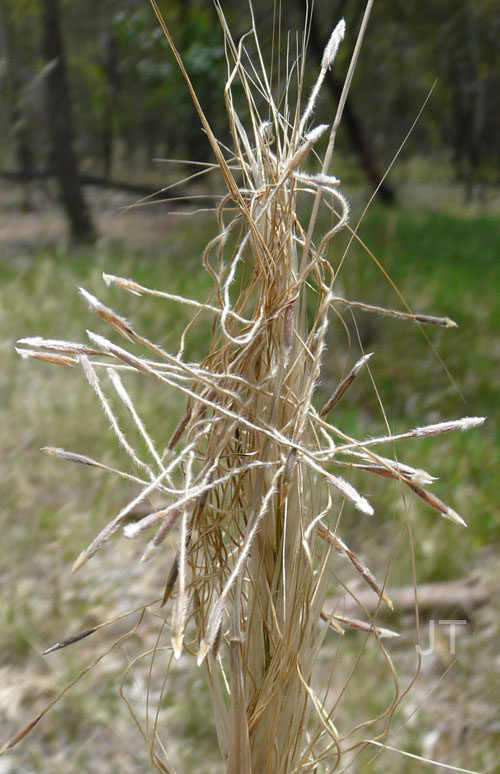
Robertson mapped the grassy flora that existed in 1981, independently of the original or existing tree cover. (Unfortunately I do not have permission to reproduce his map). He defined five classes of ground flora according to the most commonly occurring species, and noted that the boundaries between classes coincided with existing fence lines or the remains of old fence lines. All paddocks may have had similar pre-european flora, which has been modified to a varying extent by clearing, different stocking densities and type of livestock, and possible fertilizer application. The most severe modification is due to cultivation.
Note that Robertson's survey did not cover the former Greenvale Sanatorium land or Twin Dams paddock, which were later additions to the park.
Robertson's classes are:
- Exotic pasture grasses and weeds. This was mapped in the cleared southern paddocks of the Woodlands property, and some smaller areas of the Cumberland and Dundonald properties. Since Robertson's survey the southern paddocks of Woodlands mainly became dominated by Chilean Needle Grass, although several of the paddocks were subsequently resown with pasture grass by Parks Victoria.
- Low diversity Spear Grass/Wallaby Grass grassland and grassy woodland. Dominated by perennial native grasses but with exotic annual grasses and herbaceous weeds also common. This was mapped as occurring in the south-eastern part of the Woodlands property, and also the northern half other than the area described in the following paragraph. Areas mapped as this class are now dominated by Chilean Needle Grass except where the trees are dense.
- High diversity Spear Grass/Wallaby Grass grassland and grassy woodland. This was mapped as occurring in the eastern part of the picnic ground and conservation zone, the eastern and southern parts of the current back paddock, and the Gellibrand Hill area.
- Low diversity Kangaroo Grass grassland and grassy woodland. Small areas in the picnic ground and conservation zone, and a larger patch in the former back paddock. These areas are still recognisable although the latter has been heavily invaded by Patterson's Curse and Cape Tulip.
- High diversity Kangaroo Grass grassland and grassy woodland. This was mapped in the north-western half of the current back paddock. Kangaroo grass remains mainly in cleared areas and these do not have high diversity. In some of the areas with Grey Box over-story, saplings are now so dense there is no grass.
The above classification is of course an oversimplification. Smaller scale variation, such as the patches of Toowoomba Canary Grass which occur in some of the "High diversity Spear Grass/Wallaby Grass" and "Low diversity Kangaroo Grass" areas, can be missed in a grid based survey like Robertson's.
In woodland areas the species growing under trees are quite different from those growing in the open. Robertson made a more detailed study of several woodland plots within the "high diversity themeda" zone, where the open areas were dominated by Kangaroo Grass but under dense tree canopies the dominant species were winter-growing grasses including Wallaby Grasses, Weeping Grass and alien species such as Rye Grass and various Brome Grasses. Not noted by Robertson is that under many mature Red Gums the most common grass is the alien Panic Veldt Grass. Perhaps this is more common on the former Sanatorium Land than in the areas Robertson surveyed, but such trees can certainly be found in the Back Paddock as well. It seems more likely to be a legacy of livestock camping than anything which has occurred since.
Robertson found a third and more diverse species mix in what he called the halo area, stretching 2 to 5 metres from the edge of the canopy. This was dominated by Wallaby Grasses and Spear Grasses, with Red Leg Grass and the weed Rat's Tail Grass also noted as significant.